Radiation Safety
Quick links to forms:- To request a permanent badge, fill out this online form.
- To report a badge mishap, fill out this online form.
- If you have a NetId, get your radiation dose report by clicking this link.
- If you do not have a NetId, get your dose report by filling out this form.
Radiation Overview
Research conducted at CLASSE involves radiation-producing equipment (RPE) and radioactive sources, so it is incumbent upon every student, employee, and researcher to understand how to avoid radiation hazards. Signs and alarms provide warning at hazardous locations, and interlock systems prevent close proximity to equipment actively producing ionizing radiation. Further protection is afforded by shielding material surrounding such equipment. Anyone who works in controlled areas wears a radiation badge, which can later be used to confirm lack of radiation exposure. The few who work occasionally in the vicinity of residual radioactivity or with radioactive sources should, while doing so, wear protective goggles and gloves as well as ring badges if appropriate. Further detailed information on radiation safety appears in the balance of this chapter; questions should be directed to the CLASSE Safety Director. Radiation is usually classified as either ionizing or non-ionizing. Ionizing radiation is energetic enough to remove electrons from atoms and disrupt molecules in living organisms. Some examples of ionizing radiation are x-ray, beta, gamma, and neutron radiation; these can be produced by radiation-producing equipment (RPE) or by inherently radioactive material (radioisotopes). Non-ionizing radiation includes visible light, radar, microwave, infrared, radio and television signals, and electric power fields (including magnetic fields), for which health effects are considerably more subtle. Most of the radiation hazard at CLASSE is from ionizing radiation, but care must also be taken near magnetic fields. It is beyond the scope of this Handbook to detail the physiological effects of ionizing radiation. On the one hand, we all receive low levels of radiation exposure from natural sources and medical imaging. On the other hand, it is well-documented that very high levels of radiation exposure can cause genetic damage, illness, and death. Health effects from doses significantly higher than natural background but smaller than from documented cases of high exposures have been difficult to prove. Increased doses are thought to correlate with increased incidence of cancers, but no threshold or clear relationship has been definitively shown to exist in this intermediate range of exposure. Ionizing radiation is invisible, and there are no immediate symptoms from even dangerous levels of exposure. It can take years or decades for cancers to develop from high doses. Hence the custom in radiation safety is to err on the safe side by using a variety of means to restrict human exposure levels considerably below known hazardous levels, and to measure and document this lack of exposure for physical spaces and all personnel who work near RPE and/or radioactive sources.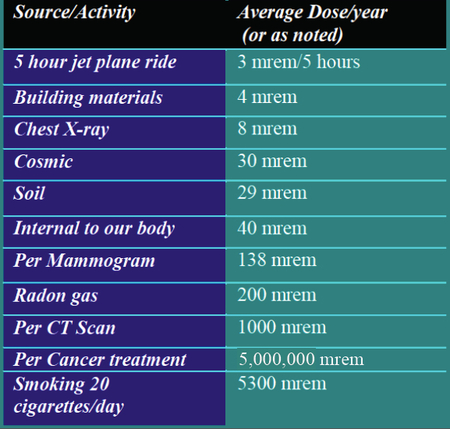 Americans receive an average annual dose of 620 mrem/yr, half of which is from natural background sources (approximately 300 mrem/yr, or just under 1 mrem/day) and half of which from medical imaging (up to hundreds of mrem per scan, depending on the type). Natural backgrounds are dominated by exposure to radon gas, but also include cosmic rays from extra-terrestrial sources and radioactivity in the soil, our bodies, and our foods.
Exposure to ionizing radiation is controlled at CLASSE by the following means:
Americans receive an average annual dose of 620 mrem/yr, half of which is from natural background sources (approximately 300 mrem/yr, or just under 1 mrem/day) and half of which from medical imaging (up to hundreds of mrem per scan, depending on the type). Natural backgrounds are dominated by exposure to radon gas, but also include cosmic rays from extra-terrestrial sources and radioactivity in the soil, our bodies, and our foods.
Exposure to ionizing radiation is controlled at CLASSE by the following means: - Signage warns of areas of potential radiation exposure; sometimes areas are roped off temporarily
- Shielding generally separates you from active radiation sources; shielding can take the form of tunnel walls and the earth surrounding them, the large concrete blocks such as found in L0, lead bricks or portions thereof, lead and other metal sheets, protective goggles and gloves, and other strategically shaped and placed materials
- A system of gates, keys, and light-beams interlocked with radiation-producing equipment ensures that radiation areas are unoccupied while the RPE is on
- Radiation monitors interlocked with radiation-producing equipment serve to limit area and personnel radiation exposure
- Personal and area badges, which record exposures for 1- or 3-month periods; by monitoring these readings, occupational exposures of personnel and particular locations are tracked
Origins of Ionizing Radiation
The electrons accelerated in the CESR bending magnets emit x-rays. Most of these x-rays are absorbed by the vacuum chamber walls, the tunnel walls, or the magnets. Higher intensity x-rays are created for CHESS in undulators and wigglers placed into the CESR ring for this purpose. X-rays can also be created in the processing of RF cavities. Particles lost from any accelerator beam also cause radiation. Particles are lost when they collide with solid material or gas molecules or interact with another beam (as in CESR). They plow into the walls of the vacuum chamber and create a cascade of gamma rays and more electrons. Gamma rays are a higher energy cousin of x-rays. Some of the gamma rays hit atomic nuclei and knock out neutrons, most of which are stopped by thick concrete shielding. A few of the neutrons change some of the nuclei of accelerator components, such as targets and beam pipes, into radioisotopes. Radioisotopes, unlike RPE, can emit radiation after the accelerator is turned off. Fortunately, only a few locations at CLASSE have residual radioactivity at any detectable level. Areas of residual radioactivity usually include the linac, the linac snouts, the injection lines, the transfer lines, the inflector magnets, and occasionally at other places along the synchrotron or CESR. A survey for radiation is done every time the interlocks are to be turned off, and all areas above 2 mrem/hour at 30 cm are marked with signs. In addition to x-ray radiation from accelerated electrons and lost beam particles, ionizing radiation at CLASSE can originate from several types of devices operated at high voltage. These include electrostatic separators in CESR, electron guns, and field emission equipment such as RF cavities.Exposure to Ionizing Radiation
A key concept in radiation protection is ALARA (As Low As Reasonably Achievable), the concept that radiation exposures should be kept as low as is possible. Cornell policy aligns itself with the requirements of the Nuclear Regulatory Commission (NRC), which requires exposure to be limited to 5000 mrem per year for radiation workers (and, like Cornell, 100 mrem per year for non-radiation workers), as shown in the table below.| Regulator | Maximum allowed dose | |
|---|---|---|
| Radiation Workers | Non-radiation workers | |
| US Nuclear Regulatory Commission | 5000 mrem per year whole-body, 50000 mrem per year extremity | 100 mrem per year |
| Cornell University | 5000 mrem* per year whole-body (*notification at 1/40 annual limit per quarter (125 mrem) & investigation at 3/40 annual limit per quarter (375 mrem), pro-rated annual limit), 50000 mrem per year extremity | 100 mrem per year |
- Time: Exposure equals exposure rate multiplied by time. Spending as little time as possible in a radiation area, waiting as long as you can after radiation-producing equipment has been turned off, and planning ahead will reduce your exposure.
- Distance: Maximizing the distance between you and the radiation source will significantly reduce your exposure.
- Shielding: Use appropriate shielding to protect yourself from unnecessary radiation. Lead shielding and source containers provide extra protection.
Controlled, Uncontrolled, and Exclusion Areas
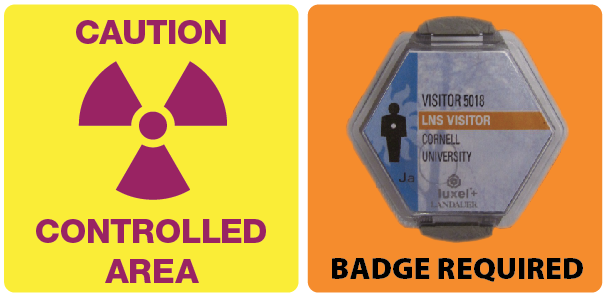
 Using the Cornell EHS Radiation Safety Manual definitions, the lab is divided into uncontrolled areas, where there is little possibility of radiation exposure, and controlled areas, where there is some possibility of exposure. In uncontrolled areas, the potential radiation dose rate must be below two mrem per hour and 100 mrem per year. No precautions need to be taken, and there is no radiation danger. All offices, building entrances, and most of (but not all) the following spaces are uncontrolled: Newman Laboratory, the Physical Sciences Building third and fourth floors, and the second and third floors of Wilson Lab.
The following are the controlled areas:
Using the Cornell EHS Radiation Safety Manual definitions, the lab is divided into uncontrolled areas, where there is little possibility of radiation exposure, and controlled areas, where there is some possibility of exposure. In uncontrolled areas, the potential radiation dose rate must be below two mrem per hour and 100 mrem per year. No precautions need to be taken, and there is no radiation danger. All offices, building entrances, and most of (but not all) the following spaces are uncontrolled: Newman Laboratory, the Physical Sciences Building third and fourth floors, and the second and third floors of Wilson Lab.
The following are the controlled areas:- CESR control room
- CESR tunnel and cross tunnel
- Linac (LS1)
- All of L0, including the pathway from East to West
- LS2 (above the linac)
- Rooms 101/102
- All CHESS hutches & caves
- Sector 7 area, where signed
Interlock Systems
The major interlock systems at CLASSE are for CESR, ERL, and CHESS; each halts beam transport into certain areas if a perimeter is breached or certain required conditions are not met. Smaller systems can also have interlocks or "interlock chains" to guarantee proper procedures are followed prior to startup.CESR interlock system
The CESR interlock system is an arrangement of gates and light beams that detect anyone walking into a radiation area at the wrong time. Electronic message boards near each entrance display the access and machine conditions. Signs and sounds provide information about the local environment. Before beam is injected from the linac, the CESR operator searches and resets all the interlocked area to guarantee only people with keys are inside. The keys prevent the accelerator from turning on. If you find yourself inside a radiation area when the warning sounds and the radiation area announcement comes over the PA system, do whichever of these three things is quickest (pull the crash cord, push a crash button, or break a light-beam interlock by stepping through it) to prevent beam coming on. When the machine is running, the board reads "synchrotron on" or "CESR on," and you may not enter. If you enter, you will interrupt the light beams, which sounds a loud siren and automatically shuts off CESR. If you break an interlock, go to the nearest beam phone to explain who you are and where you are to the CESR operator. The board will read "interlocks set" when the machine is ready to run. You may enter the area only if the sign also says "TAKE A KEY," and only with a key (because the key must be used to access controlled areas. Every person in a group must take a key and carry it until exiting interlocked areas, at which point it must be returned to its original location. (CESR cannot be turned on until all keys are returned. If you accidentally take a key from the building, call the CESR operator immediately and return the key to Wilson as soon as possible.) Never share keys. White keys allow access to all areas. Their storage box is located in the control room. While you have a white key in your possession, it is impossible for the linac, synchrotron, or CESR to generate or transport beams. When taking a key, you should sign it out. If taking more than one key for a group, inform the CESR operator how many keys are being taken and write the names of the individuals receiving the keys on the sign-out sheet. If returning more than one white key, indicate the individuals for whom the keys are being returned on the sign-out sheet and inform the operator. Colored keys available for access to specific areas are located near those areas. For example, CHESS West keys, which are yellow, allow access to CHESS West and are located in the CHESS area. To find out more about colored keys and the areas to which they allow access, speak with your supervisor or a CESR operator, or ask to see the short video (?) on the interlock system. If the sign reads "AREA SAFE," then the machine is completely off and the entire experimental area has been surveyed for residual radioactivity. Once the area has been declared safe, no keys are necessary and all experimental areas are open, but you must still wear a radiation badge (discussed later in this chapter) and pay close attention to posted warnings. Radiation monitors outside the CESR exclusion area are interlocked to the linac and/or storage ring. If beam conditions deteriorate enough that significant radiation is leaking through (or over) the shielding walls, these monitors trip off the accelerator if the instantaneous dose rate exceeds 2 mrem/hr.CHESS interlock system
The CHESS interlock system is described here.Area Radiation Monitoring
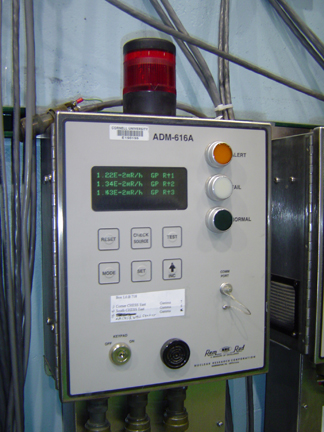 Electronic monitors in experimental areas check levels of high energy gamma, low energy gamma, x-ray and neutron radiation. If any monitor detects a radiation level that is too high, the red light on the monitor blinks and an alarm sounds, and the linac and/or CESR is automatically turned off. Anyone in an experimental area such as CHESS should immediately evacuate that area until an operator is able to reset the trip.
In addition to electronic monitors, area survey radiation badges check the level of radiation both inside and outside radiation areas twenty-four hours a day. Survey badges record the amount of radiation in any given area that is monitored.
There is one Radiation Logbook for CESR/CHESS and one for ERL, which are kept in the CESR and ERL control rooms, respectively. They contain records of radiation survey results, changes in shielding, and other changes that affect exposure levels. The Radiation Safety Technician also keeps several other logs associated with radiation monitoring.
Electronic monitors in experimental areas check levels of high energy gamma, low energy gamma, x-ray and neutron radiation. If any monitor detects a radiation level that is too high, the red light on the monitor blinks and an alarm sounds, and the linac and/or CESR is automatically turned off. Anyone in an experimental area such as CHESS should immediately evacuate that area until an operator is able to reset the trip.
In addition to electronic monitors, area survey radiation badges check the level of radiation both inside and outside radiation areas twenty-four hours a day. Survey badges record the amount of radiation in any given area that is monitored.
There is one Radiation Logbook for CESR/CHESS and one for ERL, which are kept in the CESR and ERL control rooms, respectively. They contain records of radiation survey results, changes in shielding, and other changes that affect exposure levels. The Radiation Safety Technician also keeps several other logs associated with radiation monitoring.
Radiation Shielding
Radiation shielding is strategically placed and monitored; no one should move any lead bricks or shielding without express permission of the CLASSE Safety Committee. Shielding effectiveness is only guaranteed up to a height of eight feet above ground, so do not stand on ladders, chairs, or tables within the experimental areas.Request a badge
If your job entails routinely entering controlled areas, an assigned radiation badge with your name on it should be issued to you. To request a badge, fill out this online form.Radiation Badges

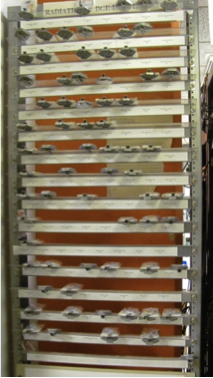 Personal radiation monitors provide the final check on the effectiveness of Lab's protective measures against ionizing radiation. Each employee, student, CHESS User, or visiting researcher with a need to pass through or work near radiation will be issued a radiation badge, similar to this visitor badge. When replaced it will be stored at one of five locations, depending on where you work most; at Newman Laboratory, G-Line (staff only), or in one of the CESR, CHESS, or ERL control rooms. Visitor badges can be signed out, providing full identifying and contact information, which we are required by law to collect for CHESS Users, short-term visiting researchers, and any CLASSE personnel who have temporarily misplaced an assigned badge.
A radiation badge does not protect you from radiation or give you an immediate reading of the radiation level. Instead, it records accumulated radiation exposure over a period of one to three months, and is read out afterwards by the badge vendor. (Each employee's exposure history is confidentially maintained by CLASSE and Cornell University.) Clip your radiation badge prominently to the front of your clothing between waist and neck only if you plan to enter a controlled area (it may not record exposure correctly if placed inside a pocket).
Virtually all of our radiation badges, worn by those whose work brings them into controlled areas, register below ten mrem for each two-month wear period. The radiation exposure anyone receives at CLASSE is much smaller than that already received from from natural sources (300 mrem annual dose from rocks, cosmic rays penetrating the atmosphere, radon, and natural radioisotopes in the human body). Radiation exposures from man-made sources are: dental x-ray (25 mrem, one-time dose), abdominal radiography (150 mrem, one-time dose), medical brain scan (2400 mrem, one-time dose), and commercial air flight crew member (450 mrem, annual dose from cosmic rays unshielded by the lower atmosphere). The exposures reported by the badge vendor have already been corrected for natural radiation sources by comparing them with reference badges that are stored on-site but away from radiation; hence reported exposures will almost always be lower than the expected dose from natural sources alone in that period, and should correspond to the exposure in the workplace alone.
Personal radiation monitors provide the final check on the effectiveness of Lab's protective measures against ionizing radiation. Each employee, student, CHESS User, or visiting researcher with a need to pass through or work near radiation will be issued a radiation badge, similar to this visitor badge. When replaced it will be stored at one of five locations, depending on where you work most; at Newman Laboratory, G-Line (staff only), or in one of the CESR, CHESS, or ERL control rooms. Visitor badges can be signed out, providing full identifying and contact information, which we are required by law to collect for CHESS Users, short-term visiting researchers, and any CLASSE personnel who have temporarily misplaced an assigned badge.
A radiation badge does not protect you from radiation or give you an immediate reading of the radiation level. Instead, it records accumulated radiation exposure over a period of one to three months, and is read out afterwards by the badge vendor. (Each employee's exposure history is confidentially maintained by CLASSE and Cornell University.) Clip your radiation badge prominently to the front of your clothing between waist and neck only if you plan to enter a controlled area (it may not record exposure correctly if placed inside a pocket).
Virtually all of our radiation badges, worn by those whose work brings them into controlled areas, register below ten mrem for each two-month wear period. The radiation exposure anyone receives at CLASSE is much smaller than that already received from from natural sources (300 mrem annual dose from rocks, cosmic rays penetrating the atmosphere, radon, and natural radioisotopes in the human body). Radiation exposures from man-made sources are: dental x-ray (25 mrem, one-time dose), abdominal radiography (150 mrem, one-time dose), medical brain scan (2400 mrem, one-time dose), and commercial air flight crew member (450 mrem, annual dose from cosmic rays unshielded by the lower atmosphere). The exposures reported by the badge vendor have already been corrected for natural radiation sources by comparing them with reference badges that are stored on-site but away from radiation; hence reported exposures will almost always be lower than the expected dose from natural sources alone in that period, and should correspond to the exposure in the workplace alone.
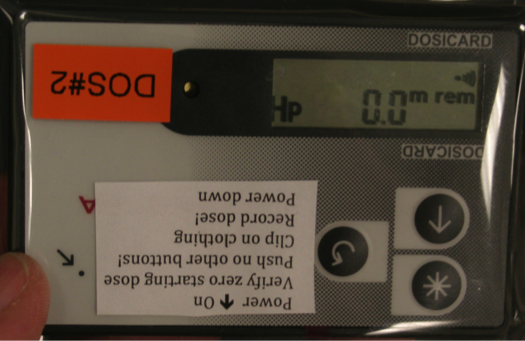 A second type of personal
radiation monitor, one that does provide immediate visual readout of the accumulated dose, is the dosimeter.
A second type of personal
radiation monitor, one that does provide immediate visual readout of the accumulated dose, is the dosimeter.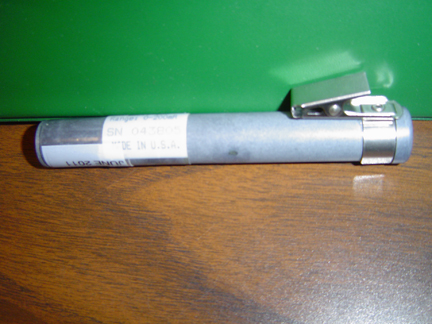 CLASSE uses both analog and digital dosimeters, as shown. Dosimeters are for use by a host or tour guide on behalf of visitors (see Giving Tours).
CLASSE uses both analog and digital dosimeters, as shown. Dosimeters are for use by a host or tour guide on behalf of visitors (see Giving Tours).
If you have had an assigned radiation badge at CLASSE (or elsewhere at Cornell) for more than one year, you can obtain your occupational radiation dose on record with EHS by clicking this link. Be aware that this dose is only the dose recorded by your radiation badge while you've worn it, and has already been adjusted to not include normal background radiation exposure. After you enter your NetId and password, a page with your information should appear (without the need for human intervention on the EHS end) after a short wait; with some browsers the pdf file does not appear but instead is downloaded automatically, so check your Downloads (or equivalent) folder.
Radiation Badge Mishaps
Radiation badges sometimes get lost or misplaced or mechanically damaged. Sometimes a user mistakenly wears a badge when getting a medical x-ray or traveling by air. You can mistakenly take someone else's badge from the rack or someone else can take yours. Rarely, badges report unusual readings due to damage or other malfunction (in this case, you will be informed of this after the badge has been processed). If anything unusual like this happens to your badge, please notify your supervisor or advisor if you are a Cornell staff or faculty member or student, the CHESS Operator if you are a visiting CHESS user, the CLASSE Safety Director, and the RSS immediately via the online Badge Mishap form (click on the preceding words). (If you were contacted first by someone else of a mishap, please respond via this form also.) It is essential that there be an accurate record of the circumstances and timing of the mishap to whatever specificity you can provide; it is also important that there be a record of your being informed of any problem with a badge. Where and when was the badge lost or irradiated? Do your best to reconstruct your activities on that day so that possible locations can be searched, and any exposures that may turn up later on a lost badge can be understood. If it can be agreed that a non-zero exposure on your badge was obtained while it was not on your possession, or not on the Cornell University campus, then the University's record of your occupational exposure should be corrected, and this form can be used to officially request such an action. If for some reason the online form does not work, please cut and paste the form below into your email compose window, fill it out, and send it to the CLASSE Safety Director, the RSS, and your supervisor:Personal Radiation Protection
If you work with radioactive materials or in radiation areas, you should be aware of some more personal safety protection devices:-
Portable survey meters: These are handheld monitors for gamma and x-ray radiation that provide instant readings. Remember to check the batteries before using one. The meters are available in the vacuum lab, the control room, the west RF transmitter, CHESS, and Newman 205. GM counters are professionally calibrated once a year. Some are used with special probes that give energy compensation and are thus highly accurate. Contact the Radiation Safety Specialist if you are unsure of which to use.
- Ring badge: Those who use intense sources to calibrate monitors, and others who demonstrate a need, can obtain ring badges from the Radiation Safety Specialist. Ring badge exposures will become part of your personal radiation records. You will be issued a set, one for each hand.
- Safety glasses and gloves: You should wear safety glasses and gloves if you are working around residual radioactivity. If you are handling sources, you may be required to wear them.
Pregnant Workers and Radiation Exposure
Because the human fetus has rapidly dividing cells and is highly sensitive to ionizing radiation, pregnant women should pay special attention to minimizing their ionizing radiation exposure. While CLASSE has developed a comprehensive Radiation Safety program of radiation monitoring, education, shielding, access controls, interlocks, and signage, it is nevertheless prudent for a pregnant worker at CLASSE to gather relevant information and understand the extra precautions available. To that end, CLASSE will provide confidential counseling and services upon request by any worker who is pregnant, or thinks she may be pregnant, and is concerned about exposure to radiation. The CLASSE Safety Director, CLASSE Safety Manager and/or the CHESS Safety Officer will generally provide these services, although with advance notice, counseling by a qualified staff member of the University Environment, Health and Safety Department can be arranged.
Topics for discussion and services include:
- Potential effects of radiation on a developing fetus.
- Badging requirements and dose limits from section 8.3 of the University Radiation Safety Manual.
- Historical radiation dose rates for relevant area badges and surveys, and typical personal badge readings for those sharing the individual's work area.
- Location and operation of radiation monitoring and accelerator interlocks in the individual's work area.
- Radiation survey of the individual's work area.
- Issuance of a dosimeter that will provide real-time readings for the individual's use.
- Instruction on use of a survey meter for real-time monitoring.
- The choice that a badgeholder has, at her discretion, to declare a pregnancy, which, if made, requires issuance of a fetal badge set.
- Whether or not a pregnancy is declared, a fetal badge set can be supplied if requested by the badgeholder with sufficient advance notice. This set consists of a control badge (which should not be worn), a whole-body badge (which should be worn between the neck and waist), and a fetal monitoring badge (which is placed over the abdomen, and, when not worn, stored with the control badge). If confidentiality is desired, the fetal monitoring badge may be worn underneath clothing, and when not worn, the control and fetal badges should be stored separately from other badges.
- All counseling and services are confidential. Identifying information will be limited to the few staff members with a need to know. The name of anyone receiving such services will not be posted in any widely accessible written or electronic logs.
Radioactive Source Handling
LEPP owns about forty-five sealed radioactive sources, and CHESS owns ten. All of these sources are registered or on a permit from the University. All LEPP sources are sealed so that no one can touch the radioactive material directly. They are solid, covered in a permanent casing. Sources are stored in a safe when not in use. Any improperly used or unattended sources will be immediately returned to the safe. The Radiation Safety Specialist (RSS) keeps an inventory of all sources, updating a logbook and card file each time a source is signed in or out. In cooperation with the Department of Environmental Health and Safety, the RSS handles ordering, receiving, moving, shipping, monitoring, and disposing of radioactive sources. The RSS also does periodic source surveys to ensure that all sources checked out are attended to and stored properly. If you are interested in using or ordering a radioactive source, see the CLASSE Sealed Source (RPH) and the RSS for a personal orientation. Use of radioactive sources is restricted to approved people and locations. Undergraduate students may only sign out sources through their advisors or supervisors. Remember to wear personal protective equipment, such as gloves, when using radioactive sources. Also remember to use the principles of time, distance, and shielding to reduce your exposure to radiation. If you believe a source may be leaking, either because it looks damaged or because radiation has been detected where it is unexpected, notify everyone in the area and seek assistance from the RSS.End of Radiation Safety
| I | Attachment | Action | Size | Date | Who | Comment |
|---|---|---|---|---|---|---|
| |
Wilson_controlled_areas(all).PNG | manage | 243 K | 25 Apr 2023 - 11:00 | RigelLochner |
 Copyright © by the contributing authors. All material on this collaboration platform is the property of the contributing authors.
Copyright © by the contributing authors. All material on this collaboration platform is the property of the contributing authors. Ideas, requests, problems regarding CLASSE Wiki? Send feedback

